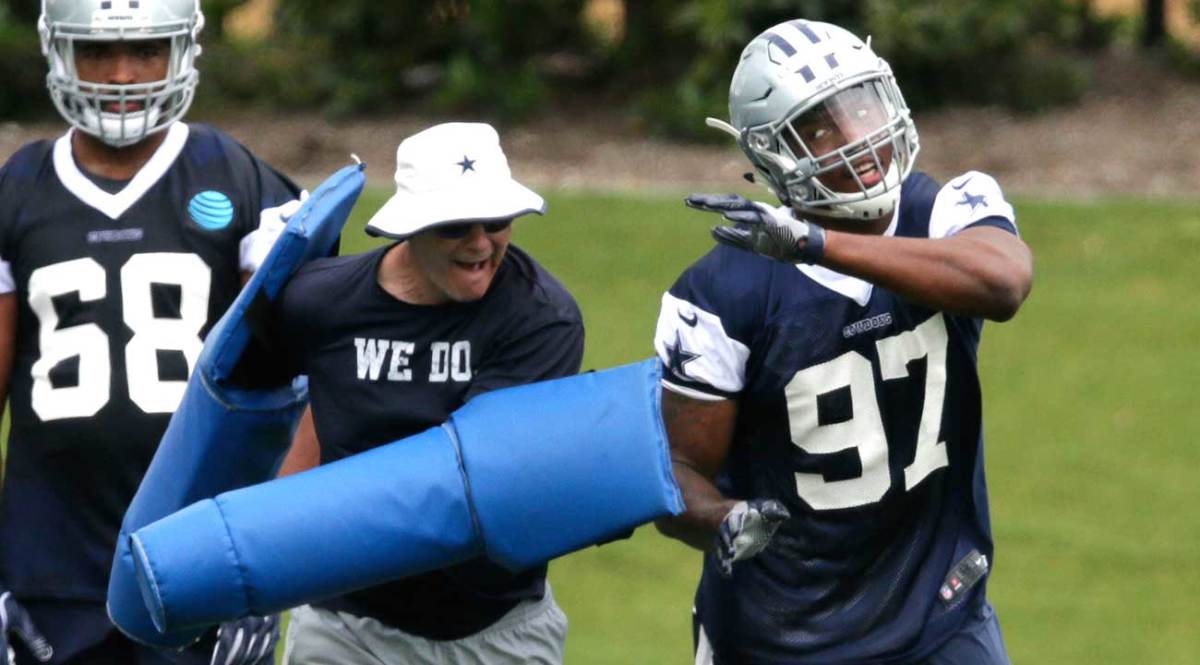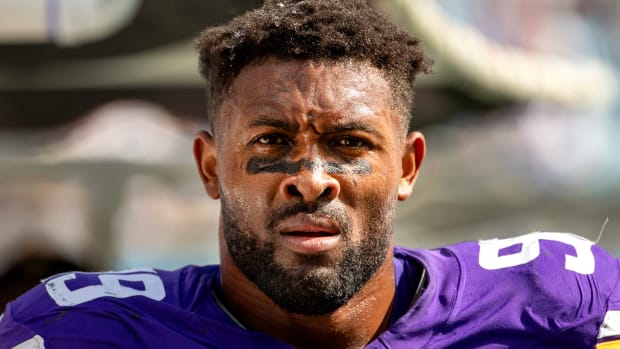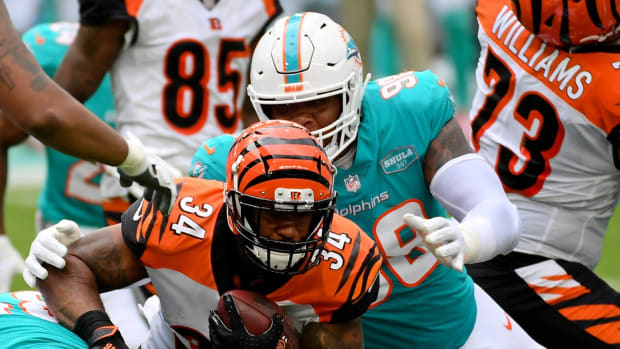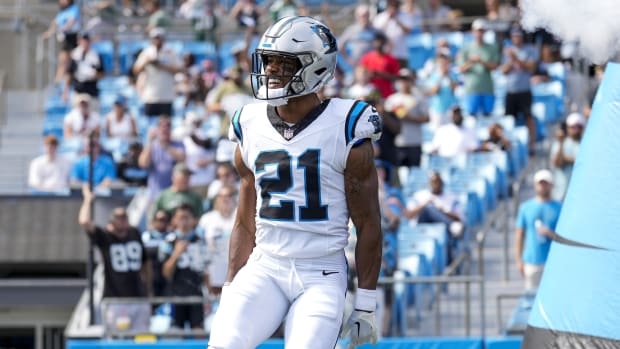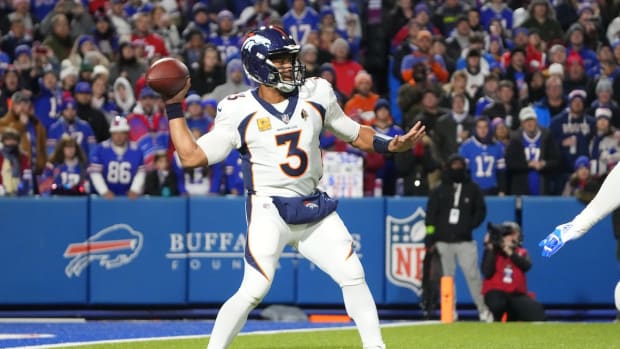Off-Season Report Cards: NFC East
DALLAS COWBOYS
2016: 13-3, 1st in NFC North. Lost in Divisional Round.
Significant Additions: G Jonathan Cooper (FA), CB Nolan Carroll (FA), S Robert Blanton (FA), DE Taco Charlton (R1), Chidobe Awuzie (R2), CB Jourdan Lewis (R3), S Xavier Woods (R6), CB Marquez White (R6)
Significant Losses: T Doug Free, G Ronald Leary, CB Brandon Carr, CB Morris Claiborne, S J.J. Wilcox
The Cowboys lost a starter from what is easily the NFL’s best offensive line when right tackle Doug Free retired. But remarkably, the line might be improved. Free’s spot will be filled by La’el Collins, the talented third-year pro who missed 13 games last season with a toe injury. Collins brings tremendous athleticism as a run-blocker. He’d been at left guard with Ronald Leary, who defected to Denver. And so the Cowboys will be the latest team to try Jonathan Cooper here. The oft-injured 2013 first-round pick has had failed stints with the Cardinals, Browns and Patriots. On the glass half full side: Cooper has never been flanked by talent like left tackle Tyron Smith and center Travis Frederick. In a zone scheme such as Dallas’s, playing in a group of quality linemen can elevate a player. (See Cooper’s predecessor, Leary, for example.) If Cooper flames out, his career will almost surely end, and the Cowboys will make due with Joe Looney or Byron Bell, two fringe players signed over from Tennessee in 2016 and 2017 respectively.
No other work was needed on the Cowboys’ offense. The defense, of course, was a different story. Entering the draft, Jerry Jones and the front office had to restock a secondary that had lost three starters in free agency: corner Brandon Carr to the Ravens, corner Morris Claiborne to the Jets and safety J.J. Wilcox to the Bucs. To fill these voids, the Cowboys, after signing improved-but-not-spectacular Eagles corner Nolan Carroll in free agency, drafted corners Chidobe Awuzie (Colorado) in the second round, Jourdan Lewis (Michigan) in the third and Marquez White (Florida State) in the sixth. They also got safety Xavier Woods in round five. He’ll compete with incumbent Jeff Heath and journeyman backup Robert Blanton (signed over from Buffalo).
The beauty of this secondary is that its three best players are versatile. Third-year pro Byron Jones might be the only defensive back in football who can truly play anywhere. He has the range to operate in centerfield, he’s a good enough tackler to venture into the box, he’s strong enough to press receivers on the outside, and he possesses the twitchy quickness to battle in the slot. Jones can answer a lot of problems. In addition to him, top corners Orlando Scandrick and Anthony Brown (a tremendously underappreciated sixth-round pick last year) can play inside or outside. With Jones, Scandrick and Brown all capable of filling so many different roles, the Cowboys can tailor their game plans to opponents while also making that game plan more user-friendly for the rookies. With three guys who can do so many things, no rookie DB will have to do something he’s not comfortable doing.
COWBOYS AND MEDIA: How journalism layoffs affect the coverage of America’s most popular team
The reason the Cowboys didn’t address their secondary in the draft’s first round is that they badly needed pass-rushing help. Defensive coordinator Rod Marinelli doesn’t like to blitz. Instead he favors four-man D-line rush tactics like stunts, twists and grouped slants. Part of the reason he does this is he has a lot of mediocre front-four players who can’t consistently win on their own and need aid from the scheme. Marinelli will still have to lean on these tactics in 2017, but the hope is that with No. 28 overall pick Taco Charlton aboard, it won’t be quite as heavily. A lot is riding on Charlton. With Demarcus Lawrence battling back problems in recent years and David Irving being only a part-time player, the Cowboys really don’t have another pass rusher who can bend the edge snap after snap.
Grade: C+
* * *
NEW YORK GIANTS
Last Year: 11-5, 2nd in NFC East. Lost in Wild-Card Round.
Significant Additions: WR Brandon Marshall (FA), OL D.J. Fluker (FA), TE Evan Engram (R1), DT Dalvin Tomlinson (R2), DE Avery Moss (R5)
Significant Losses: WR Victor Cruz, K Robbie Gould
The addition of Brandon Marshall is critical. His big-bodied catching style perfectly fits an offense that relies heavily on slant routes. And, obviously, with Odell Beckham around, Marshall won’t see the types of double-teams and zone-coverage rotations he saw with the Jets. Marshall’s only real adjustment will be where he lines up. With the Jets he was often an X-iso receiver, meaning he was by himself on the weak side. But that’s usually Beckham’s role. Marshall’s other playing spot was the slot, which is filled on the Giants by Sterling Shepard.
Most likely, Marshall will see more snaps as a flanker—the receiver who lines up on the side of the tight end. That tight end will be first-round rookie Evan Engram. This is the first true middle-of-the-field threat the Giants have had in the Beckham era. Engram is young and raw but should immediately supplant the supremely limited Will Tye.
It remains to be seen how good of a run-blocker Engram can be. Mediocre blocking at tight end has hindered the Giants’ ground game, which is predicated on basic inside zone runs from shotgun. Barring unexpected greatness from fourth round rookie Wayne Gallman, it won’t be a dynamic backfield. Incumbent back Paul Perkins has decent lateral agility but not quite enough of it to consistently create his own yards. (Though with a year under his belt and increased first-team reps this offseason, perhaps he’ll be a more comfortable runner in 2017.) Shane Vereen is almost strictly a “backfield receiver.”
The Giants don’t have the type of offensive line that can consistently pave lanes for ball-carriers. It was once thought that massive 2013 first-rounder D.J. Fluker could be that, but after four so-so seasons in San Diego, the Chargers let him walk. Expect Fluker to vie for a starting spot along the right side, either at tackle (replacing Bobby Hart) or guard (replacing John Jerry). Too bad Fluker can’t play left tackle; that’s the one position where New York could really stand to improve (so far 2015 first-round pick Ereck Flowers has not panned out).
On defense, instead of paying known-entity Jonathan Hankins roughly $10 million a year to continue at tackle, the Giants spent a second-round pick on Dalvin Tomlinson. They’d love for him and fifth-round defensive end Avery Moss to spark a more successful pass rush. Last year’s big-money free agent pickup, Olivier Vernon, was superb in run defense (better in this department than any other D-end in the league, in fact), but he had only 8.5 sacks, spearheading an often futile four-man rush.
Strangely enough, that Giants’ pass rush also had another upper-echelon defensive end: Jason Pierre-Paul. He was re-signed for $62 million over four years. Like Vernon, Pierre-Paul is a monster against the run. And it’s not like these two can’t put the heat on quarterbacks. Both just need to do it more regularly.
Typically an impotent pass rush fells a defense. But the Giants have something no other team has save for the Broncos: three high-quality pure cover corners: Dominique Rodgers-Cromartie plus last year’s newcomers, Janoris Jenkins and Eli Apple. As long as these guys are on the field, defensive coordinator Steve Spagnuolo can dial up any blitz imaginable. And he does. Spagnuolo can be especially creative with his blitzes out of two-safety coverages, which is unusual (in most blitzes there’s just one safety back).
The only tenuous thing with this defense is its depth. If any of the corners are out, it’s in trouble. Recall the playoff loss last year at Green Bay. Rodgers-Cromartie left with a thigh injury on the first series. That compromised part of the man coverage’s reliability, which wiped several blitz packages off Spagnuolo’s play sheet. Eventually Aaron Rodgers exploited this.
Grade: B+
* * *
PHILADELPHIA EAGLES
Last Year: 7-9, 4th in NFC East
Significant Additions: WR Alshon Jeffery (FA), RB LeGarrette Blount (FA), WR Torrey Smith (FA), DE Chris Long (FA), DT Timmy Jernigan (FA), DE Derek Barnett (R1), CB Sidney Jones (R2), CB Rasul Douglas (R3), RB Donnel Pumphrey (R4), WR Mack Hollins (R4), WR Shelton Gibson (R5)
Significant Departures: DE Connor Barwin, NT Bennie Logan, CB Nolan Carroll, CB Leodis McKelvin
Perhaps the biggest name in free agency this year was Alshon Jeffery. The Eagles got him with a one-year, $9.5 million deal. Worst-case scenario: The long, strong-handed ex-Bear incurs more of the injuries and failed PED tests that hurt him in Chicago. Best-case scenario: He fixes a shoddy receiving corps that neutered Doug Pederson’s offense in 2016. The Eagles needed to do something here. Their wide receivers were so slow and undependable last season that Pederson often chose to operate out of two-tight-end sets in obvious passing situations. That’s unheard of in today’s NFL, where three-receiver sets are the norm.
Not only is Jeffery a receiver you never take off the field, he’s also one who can draw extra safety help. That will clarify the coverage reads for the team’s budding star quarterback. Carson Wentz was already stellar at identifying coverage, and with 16 games now under his belt, his classroom football IQ should translate more to the field. This will eventually lead to a more vertical passing game. Last season, to keep things manageable for their rookie QB, Pederson and his staff encouraged Wentz to get the ball out quickly. A guaranteed seven-yard completion was almost always preferable even to a very likely 20-yard completion. But make no mistake: Wentz has the arm, toughness and field vision to make those 20-yarders. He’s similar to Andrew Luck in his ability to extend plays. Jeffery makes it easier for Wentz to choose these spots.
In case there was any doubt about the futility of this receiving corps, the Eagles added three other players to it: veteran Torrey Smith (signed over from San Francisco), fourth-round pick Mack Hollins and fifth-rounder Shelton Gibson. Most likely, the only receiver from last year who will remain a regular contributor is possession slot man Jordan Matthews.
Of these three newcomers, Smith will get the best crack at playing time. It’ll be interesting to see how he fits Pederson’s offense. Smith is a stiff, limited route-runner, which can be especially problematic in a system built on the timing and spacing of route combinations. However, he still has straight-line speed that defenses must honor. How much will Pederson build around that? Even if Smith isn’t getting the ball, such speed can be used to impact safeties, which frees up other targets.
The rest of Philly’s offense is relatively unchanged. Running back LeGarrette Blount is a familiar name, but with fourth-round pick Donnel Pumphrey coming aboard, and incumbents Ryan Mathews, Darren Sproles and Wendell Smallwood being more diverse players, it’ll be tough to find him snaps. Up front, the Eagles did not address left tackle, with this year’s free agent and draft classes being so weak at that position. Instead they’ll stick with Jason Peters. His 35 years of age now show, but the belief is he can grind for one more year.
On defense, the personnel has been shuffled, starting up front. Sturdy veteran Connor Barwin was released. In his stead is Chris Long, another sturdy veteran who can set the edge against the run, and first-round pick Derek Barnett, who figures to at first be a pass-rushing specialist behind Long.
At nosetackle, Bennie Logan signed with Kansas City; in his spot (sort of) is ex-Raven Timmy Jernigan. We say “sort of” because Logan was a gap-clogger who could dominate with strong east/west movement. Jernigan is more of a north/south gap-shooter. His best position is three-technique (i.e. between the guard and tackle). He and Fletcher Cox can each line up at a three-tech spot on third downs, but on first and second down, one of those two will have to align tighter inside, between the guard and center (i.e. at “nose shade”). Cox might be the best all-around three-tech in football; the guess here is Jernigan will play the nose. But can he?
Changes abound in the secondary, too. Starting corners Nolan Carroll and Leodis McKelvin were allowed to walk in free agency. (Both could be effective at times, but neither was effective all the time. McKelvin could be especially up and down.) Journeyman Patrick Robinson was signed in free agency, but the real additions were second-round pick Sidney Jones and third-round pick Rasul Douglas. They’ll be counted on to start in nickel in 2018. For Douglas, it could even be sooner. For Jones, it will be whenever his torn Achilles is healed.
Defensive coordinator Jim Schwartz believes in straightforward, fundamentally sound football. That is to say, he doesn’t riddle his scheme in complexities. Theoretically, this should make it easier for newcomers to contribute right away.
Grade: B-
* * *
WASHINGTON REDSKINS
Last Year: 8-7-1, 3rd in NFC East
Significant Additions: WR Terrelle Pryor (FA), LB Stacy McGee (FA), LB Terrell McClain (FA), S D.J. Swearinger (FA), DL Jonathan Allen (R1), DE Ryan Anderson (R2), CB Fabian Moreau (R3), RB Samaje Perine (R4)
Significant Departures: GM Scot McCloughan, DC Joe Barry, WR DeSean Jackson, WR Pierre Garçon
Things are still messy, but at least Washington got QB Kirk Cousins back for at least another year. Cousins’s experience in Jay Gruden’s offense is important. This year, that offense will be getting the ball to a pair of new receivers: ex-Brown Terrelle Pryor and last year’s first-rounder Josh Doctson, who has played only 31 NFL snaps because of injury. Collectively, Pryor and Doctson might be an upgrade in talent over predecessors DeSean Jackson (now a Buc) and Pierre Garçon (now a Niner). But in Gruden’s scheme, diversity at wide receiver is important. With so many of its route designs intertwined, it’s imperative to have someone who can lift the coverage deep (that was Jackson) and threaten it inside (that was Garçon). Pryor drastically improved his route-running last season in Cleveland; it’s vital he continue on that trajectory. What Doctson can do remains to be seen.
Most likely, Washington will have to rely on getting better balance from its ground game. Rob Kelley is now The Guy. Samaje Perine was drafted in the fourth round as a rotational piece; it won’t be long before he formally captures Matt Jones’s roster spot.
• PETER KING’S OFF-SEASON POWER RANKINGS:Part I, 32-17 | Part II, 16-2
Defense is where this team needed the most help. Gruden fired coordinator and friend Joe Barry and replaced him in-house with linebackers coach Greg Manusky. When Manusky coordinated the Colts defense (2012-15) he ran a diverse, pressure-heavy scheme. But that was likely a function of head coach Chuck Pagano’s desires. In Washington, expect Manusky to take more of the straight coverage-based approach that Barry took. Under Barry, it was a lot of zone coverage early in the season, with increased doses of man-to-man down the stretch.
If you’re a straight coverage-based defense, you need dynamic pass rushers. Defensive backs can’t be expected to hold their coverage for more than 3.0 seconds (and 2.5 seconds if it’s a Cover 2-type zone coverage). Washington knows this. And so it was no surprise when they drafted Alabama’s Jonathan Allen in the first round and Ryan Anderson in the second. Mock drafts had Allen listed as a defensive end, but he’ll almost certainly play tackle in nickel, which is the defensive package of choice over 60 percent of the time. The selection of Anderson, a purer edge guy who weighs about 30 pounds less than Allen, only verifies this. He’ll play opposite Ryan Kerrigan. Remember, Junior Galette was originally supposed to fill this role, but he’s missed the last two years with Achilles injuries. Anything he provides this season will be bonus.
The rookies aren’t the only newcomers up front. Underrated ex-Raider Stacy McGee has a good mix of brute strength and agility, particularly in his upper-body movement. He’ll help on first and second downs. So will Ex-Cowboy Terrell McClain, another big guy who moves better than you’d guess.
These new front-seven acquisitions present more freedom for how the team can use 2014 second-round pick Trent Murphy and 2015 second-rounder Preston Smith. Murphy, who is suspended for the first quarter of this season, has toggled at different positions up front. Smith has been a little steadier, playing mostly outside. However, he doesn’t quite have the mix of explosiveness and elasticity to be a true edge-bender. (If he did, Washington would not have drafted Anderson.) Smith’s best role—and Murphy’s, too, for that matter—is as a hybrid joker on passing downs. Have him rove around the formation.
It’ll be interesting to see if either can play strong-side linebacker in a base 4-3. Both have the bodies for it. The question will be coverage. Whoever is at strong-side linebacker will play alongside Bills free agent Zach Brown, a gifted chaser but up-and-down field-reader.
Washington’s defense has more personnel options up front, and also in the secondary. That doesn’t mean there are great options, though. The third-round selection of Fabian Moreau presents even more depth at cornerback; the team will be fine there. The question is at safety. There are a bunch of strong safeties on the roster but no reliable free safeties. The hope is that D.J. Swearinger, signed from Arizona, can fill the role. He hasn’t always been the most disciplined, but to his credit, he matured tremendously with the Cardinals, and their staff felt he would have been an adequate centerfielder. Still, Swearinger is at his best in the box. Those duties, however, will likely be handled by last year’s second-rounder, Su’a Cravens. Behind Swearinger, there are more options, but none that are great. DeAngelo Hall, 33 and coming off his third major injury in as many years (this time an ACL), can’t be counted on. Will Blackmon, a converted corner, was up-and-down at safety last year. Montae Nicholson, the fourth-round rookie, will get a look.
Grade: B
Question or comment? Email us at talkback@themmqb.com.
































